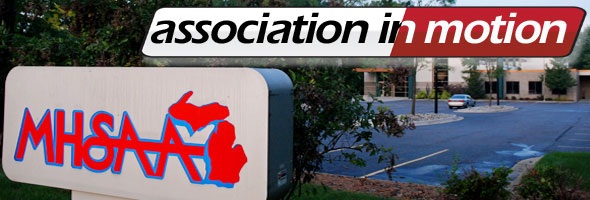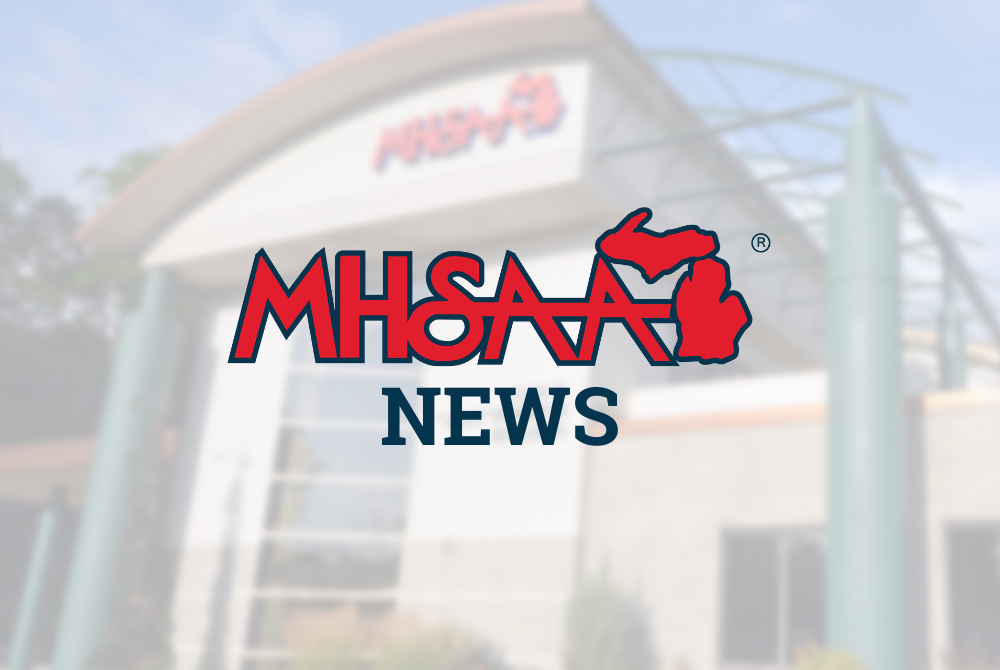
Participation Again Outpaces Population
August 26, 2019
By Geoff Kimmerly
Second Half editor
For the third straight school year, Michigan in 2018-19 had the eighth-most participants in high school sports nationally according to statistics recently released by the National Federation of State High School Associations, again outpacing the state’s national ranking of 10th for total number of residents of high school age.
Michigan’s participation ranking was based on a number of 292,947, with 126,342 girls and 166,605 boys taking part in high school athletics, and included sports in which the Michigan High School Athletic Association does not conduct postseason tournaments. The totals count students once for each sport in which he or she participates, meaning students who are multiple-sport athletes are counted more than once.
The state’s girls participation ranked eighth nationally for the third straight year, while boys participation fell back to eighth, after moving up one spot to seventh during 2017-18. However, as with overall population, Michigan continued to rank 10th for both females and males ages 14-17 according to the latest U.S. Census Bureau estimates from 2018.
A total of 19 sports bested the state’s overall national participation ranking of eighth by placing seventh or higher on their respective lists. Four Michigan sports improved in national ranking during 2018-19, while the state fell in the rankings of five sports.
Perhaps the most notable improvement among Michigan sports came in boys bowling, where Michigan moved up one spot to second – its highest ranking in any of the 28 sports under MHSAA administration. Michigan previously ranked second nationally in boys bowling as recently as 2013-14 before falling to third for the last four years. Michigan’s boys tennis participation moved up one spot as well to fifth on its ranking list, while girls track & field moved up one spot to seventh and girls lacrosse moved up one spot to 13th after a one-year drop back in 2017-18.
Three of five sports that fell on participation lists still outpaced Michigan’s overall participation rank – girls volleyball fell one spot to fifth, while girls golf and girls competitive cheer both fell one spot to sixth on their respective rankings lists. Other Michigan sports that ranked eighth or higher in 2018-19 were baseball (eighth), girls basketball (sixth), boys basketball (seventh), girls bowling (fourth), girls and boys cross country (both seventh), 11 and 8-player football (sixth and seventh, respectively), boys golf (sixth), boys ice hockey (fourth), girls and boys skiing (both third), girls softball (seventh), girls tennis (third) and boys track & field (seventh).
Boys lacrosse, girls soccer and boys and girls swimming & diving participation all slotted ninth on their respective lists, holding to their 2017-18 rankings and placing still ahead of where Michigan slotted for high school-aged population. Michigan wrestling participation fell two spots to ninth nationally, but still outpaced population, and boys soccer fell one spot to 10th. Girls gymnastics participation ranked 11th nationally for the second straight year.
National participation in high school sports in 2018-19 declined for the first time in 30 years – but the total of 7,937,491 participants still ranked third highest all-time, consisting of 4,534,758 boys and 3,402,733 girls.
Girls volleyball saw the largest increase in participants nationally with 6,225 more this past year over 2017-18, followed by boys track & field (+5,257), girls soccer (+3,623) and girls lacrosse (+3,164).
Football, despite a 5.8-percent decrease from 2017-18, remained the most-played high school sport nationally with 1,006,013 participants. Boys track & field (605,354), boys basketball (540,769), girls track & field (488,267), baseball (482,740), boys soccer (459,077) and girls volleyball (452,808) all saw at least 400,000 participants, while girls basketball (399,067) and girls soccer (394,105) approached that total.
The top 10 states by participants remained the same in 2018-19. Texas and California topped the list again with 825,924 and 824,709 participants, respectively, followed by New York (369,266), Ohio (339,158), Illinois (333,838), Pennsylvania (316,429), Florida (308,173), Michigan (292,947), New Jersey (281,058) and Minnesota (240,487). Only Texas, California and Minnesota reported higher figures than the previous year.
The participation survey has been compiled in its current form by the NFHS since 1971 through numbers it receives from its 51 member state associations, including the District of Columbia. Click to see the complete 2018-19 High School Athletics Participation Survey.
The NFHS, based in Indianapolis, Indiana, is the national leadership organization for high school sports and performing arts activities. Since 1920, the NFHS has led the development of education-based interscholastic sports and performing arts activities that help students succeed in their lives. The NFHS sets direction for the future by building awareness and support, improving the participation experience, establishing consistent standards and rules for competition, and helping those who oversee high school sports and activities. The NFHS writes playing rules for 16 sports for boys and girls at the high school level. Through its 50 member state associations and the District of Columbia, the NFHS reaches more than 19,500 high schools and 12 million participants in high school activity programs, including almost 8 million in high school sports. As the recognized national authority on interscholastic activity programs, the NFHS conducts national meetings, sanctions interstate events, offers online publications and services for high school coaches and officials, sponsors professional organizations for high school coaches, officials, speech and debate coaches, and music adjudicators; serves as the national source for interscholastic coach training and serves as a national information resource of interscholastic athletics and activities.
The MHSAA is a private, not-for-profit corporation of voluntary membership by more than 1,500 public and private senior high schools and junior high/middle schools which exists to develop common rules for athletic eligibility and competition. No government funds or tax dollars support the MHSAA, which was the first such association nationally to not accept membership dues or tournament entry fees from schools. Member schools which enforce these rules are permitted to participate in MHSAA tournaments, which attract more than 1.4 million spectators each year.

Survey Shows Small but Steady Rise of Multi-Sport Participation at MHSAA High Schools
By
Geoff Kimmerly
MHSAA.com senior editor
December 16, 2025
The Michigan High School Athletic Association’s seventh Multi-Sport Participation Survey, conducted last spring for the 2024-25 school year, showed small but continuing growth of multi-sport participation among athletes at member high schools.
The annual Multi-Sport Participation Survey was inspired by the MHSAA’s Task Force on Multi-Sport Participation, which was appointed in 2016 to study early and intense sport specialization – a serious issue related to health and safety at all levels of youth sports – and to promote multi-sport participation as a way to help stave off overuse injuries and burnout among athletes that have been tied to chronic injuries and health-related problems later in life.
The 2024-25 Multi-Sport Participation Survey received responses from 82.7 percent of member high schools and showed 45.4 percent of athletes at those MHSAA member high schools participating in two or more sports, an increase of six tenths of a percent from 2023-24. Multi-sport participation has shown increases every year of the study – and a combined increase of 2.6 percent since the first study after the 2017-18 school year.
For 2024-25, 47.8 percent of male athletes and 42.3 percent of female athletes played multiple sports. The percentage of multi-sport athletes remains inversely proportional to schools’ enrollments, as Class D schools again enjoyed the highest percentage of multi-sport athletes at 63.1 percent, followed by Class C schools (59.6), Class B (49.3) and Class A (38.5).
All four enrollment classifications also continued to show increasing multi-sport participation. Class A multi-sport participation increased three tenths of a percent from 2023-24 and is now up 2.6 percent from 2017-18 survey results. Class B increased 1.3 percent from the previous year and is also up 2.6 percent since 2017-18. Class C multi-sport participation grew two tenths of a percent over the previous year and sits 4.4 percent higher than the first study, and Class D multi-sport participation in 2024-25 remained the same as in 2023-24 and has grown five percent over the last seven years.
The MHSAA Task Force also recommended measuring multi-sport participation in MHSAA member schools to recognize “achievers” – that is, schools that surpass the norm.
Battle Creek Harper Creek, Detroit Cody and Grand Rapids Northview have appeared among the top 10 percent of their respective Classes six of the seven years the survey has been conducted. Four more schools have appeared among the top 10 percent of their Classes five of the seven years: Decatur, East Grand Rapids, Manton and Warren Michigan Collegiate. Detroit Douglass, Parma Western and Lake Leelanau St. Mary have appeared among the top 10 percent of their Classes four times apiece.
In Class A, Grand Rapids Northview (79.4 percent) posted the highest percentage of multi-sport athletes for 2024-25, followed by Macomb L’Anse Creuse North (70 percent), Detroit Cass Tech (61.4) and Sterling Heights Stevenson (60.7) also reporting at least 60 percent.
Warren Michigan Collegiate paced Class B schools with 91.3 percent of athletes playing multiple sports, followed by Tecumseh (77.7), Yale (76.6), Detroit Cody (71.4), Battle Creek Harper Creek (71.3) and Manistee (70.1). Class C saw six schools reach 80 percent for the second-straight school year, led by Jackson Lumen Christi (97.6 percent), Martin (89.7), Bad Axe (89.3), Cass City (88.6), Center Line Prep Academy (83.6) and Decatur (82.3).
Watervliet Grace Christian topped the Class D list at 93.8 percent of athletes participating in multiple sports. Next were Watersmeet (89.7), Lake Leelanau St. Mary (88.2), Detroit Douglass (87.8), Vestaburg (87.7) and Portland St. Patrick (87.3).
The full summary report on the Multi-Sport Participation Survey is available on the “Multi-Sports Benefits” page.

